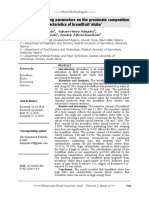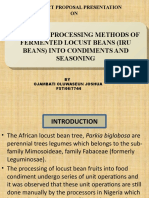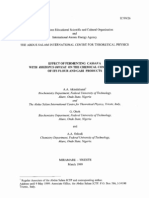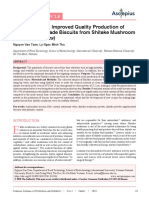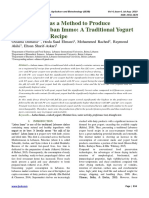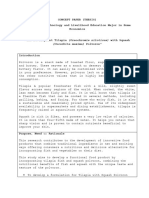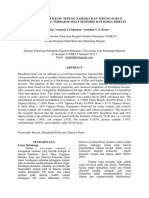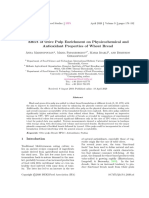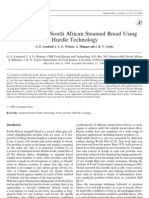Professional Documents
Culture Documents
Manufacture and Physicochemical Characterization of Safou (Dacryodes Edulis) Pulp-Based Chips in Congo-Brazzaville
Original Title
Copyright
Available Formats
Share this document
Did you find this document useful?
Is this content inappropriate?
Report this DocumentCopyright:
Available Formats
Manufacture and Physicochemical Characterization of Safou (Dacryodes Edulis) Pulp-Based Chips in Congo-Brazzaville
Copyright:
Available Formats
Volume 8, Issue 4, April 2023 International Journal of Innovative Science and Research Technology
ISSN No:-2456-2165
Manufacture and Physicochemical Characterization of
Safou (Dacryodes Edulis) Pulp-based Chips in
Congo-Brazzaville
Franchelle Constance Bakeni Moukani1, Irène Itoua1, Marina Kissita1, Jocelyne Rénée Laurence Dhellot1
Laboratoire de Valorisation des Agro-ressources (LVAR), ENSP,
Université Marien N’GOUABI, P.O. Box : 69, Brazzaville, Congo
Abstract :- The aim of this work is to manufacture a After each harvest season, a large quantity of safflower
snack product based on local products, including the fruit is discarded due to softening because of the lack of
pulp of safou. The saffron was precooked in hot water to means of conservation, processing and marketing [7]. The
extract the pulp. The pulp obtained was mixed with existing techniques are much more oriented towards the
other ingredients to obtain a batter. Three (03) types of extraction of the safflower oil and the transformation of the
pastes were obtained: a simple or plain paste (containing pulp into paste [8]. The transformation of safflower into
no ingredients), a salted paste and a sweet paste. The chips becomes an alternative to ensure the permanent
doughs were fried at 150 (plain chips), 160 (salted chips) availability of safflower-based products during the periods
and 170 °C (sweet chips) to give plain chips, salted chips when safflower is not produced, to fight against post-harvest
and sweet chips. The biochemical composition of the losses and to add value to the fruits of the safflower tree.
chips showed protein contents ranging from 5.85±0.15
and 7.42±0.12% for the salted and plain chips Potato chips, also known as potato chips in Canada,
respectively. The lipid content varied between 65.51±0.29 are thin vegetable slices fried in oil, which makes them
and 69.32±0.30% for salted and plain chips respectively. crunchy. They are made of potatoes, but can also be made of
The chips obtained are rich in minerals with Ca and P vegetables (cassava, sweet potato, beet, kale etc.) or fruits
contents of 64.04 and 70.37 mg for salted chips and 31.86 (apple, banana, durian, etc.) [9].
and 45.78 mg for sweet chips, respectively.
This study consists in the development of a
Keywords:- Nutritional value, fried, pulp, mineral salts, manufacturing process of a snack product, in particular the
chips. chips from the pulp of safou. Thus this work is divided into
four (04) parts namely: introduction, material and method,
I. INTRODUCTION results and discussion and finally the conclusion.
According to the FAO, Africa has 60% of the world's II. MATERIALS AND METHODS
uncultivated land. This makes it dependent on imports [1].
For in 2020, according to UNCTAD, nearly 80% ($ 60.5 A. Plant material
billion) of the food commodities consumed by African The experimental material is mainly made up of safous
countries came from outside the continent. During this time, purchased in Makoua in the Cuvette Department.
the African continent has many forest resources. In this
wealth, NTFPs (non-timber forest products) represented by Experimental protocol
several species, capable of preserving and improving the Extraction of the safou pulp and formulation of the
food level of the most fragile rural and urban populations, batter
are in a good place [2]. Sub-Saharan Africa has 312 million The extraction of the pulp of safou and the formulation
hectares of cultivable land. Congo-Brazzaville alone has an of the paste to be fried it makes according to the diagrams
area of 10 million hectares [3]. Among the crops grown is presented in figure 1 below:
the safflower (Dacryodes edulis), which produces fruits
called safou.
The safflower (Dacryodes edulis) belongs to the
family of the Burseraceae [4]. It is a forest tree that has
several therapeutic properties. Its fruit, called safflower, has
a nutritious pulp that contains 40 to 65% lipids [5] and 10 to
30% protein [6].
IJISRT23APR564 www.ijisrt.com 2089
Volume 8, Issue 4, April 2023 International Journal of Innovative Science and Research Technology
ISSN No:-2456-2165
Sorting Reception of safou pulp
Cleaning Mixing with ingredients
Weighing
Moulding
Bleaching
Frying
De-foiling
Removal of the surface oil
Mixing
Safflower pulp Preservation and storage
Conservation and storage
1- Extraction of safou pulp 2- Frying to obtain chips
Fig. 1: Chip manufacturing diagram
Formulation :
For the preparation of safflower paste, the formula presented in Table I was used :
Table 1: composition of the mixture of safflower paste
Ingrédients Safflower pulp (g) Salt (g) Sugar (g)
Nature of the product
Plain potato chips 100 - -
Salted potato chips 100 2.5 -
Sweet potato chips 100 - 2.5
Three types of chips were made : plain chips (without Ash content [12]
salt and sugar) cooked at 150 °C, salty chips cooked at 160 The ash content is obtained after incineration of the
°C and sweet chips cooked at 170 °C. potato chip grit at a temperature of 450-550 °C in an
electrically heated muffle furnace for 8 h until a constant
B. Physico-chemical analysis mass is reached.
Water content [10] Crude fiber content [13]
The water content was determined after drying 10 g of Determination of the fiber content of the composite
chip sample in the oven (INDERLAB 0 - 250 °C) at 105 °C flour according to the AOAC method [13]
for 24 h.
Carbohydrate content (AOAC, 2005) [14]
Protein content [11] The carbohydrate content was determined according to
The protein content was determined after determination the method proposed by AOAC:
of total nitrogen according to the Kjeldahl method (VELP
SCIENTIFICA DK 6) after sulfuric mineralization in the % Carbohydrates = 100 - (% Water + % Protein + %
presence of selenium catalyst. The nitrogen content value Fat + % Ash) (1)
obtained was multiplied by 6.25 to quantify the protein
content. Energy value
The energy value was calculated using Atwater's
Lipid content [12] specific coefficients for protein, fat and carbohydrate [15].
The extraction of lipids was done by n-hexane using the
Soxhlet (PIERRON 250 mL). After extraction, the oil Energy value (Kcal) = [(% Carbohydrates × 4) + (%
obtained was placed in an oven at 50 °C to evaporate the Protein × 4) + (% Fat × 9)](2)
remaining solvent.
IJISRT23APR564 www.ijisrt.com 2090
Volume 8, Issue 4, April 2023 International Journal of Innovative Science and Research Technology
ISSN No:-2456-2165
Mineral content Hedonic tests
The phosphorus was determined by spectrocolorimeter. The hedonic tests were carried out on 14 people. Four
The potassium, calcium and magnesium were determined by (04) parameters were evaluated, namely, taste, flavor, color
flame photometry with wave lengths of 766 nm. and texture.
III. RESULTS ET DISCUSSION
The manufactured chips are shown in Figure 2 below:
Plain chips Sweet chips Salty chips
Fig. 2: The three categories of manufactured chips
A. Physico-chemical characteristics of the chips
The physico-chemical composition of the chips is presented in the following table II:
Table 2: Physico-chemical composition of chips
Nature de chips Chips natures Salted chips Sweet chips
Température (°C) 150°C 160°C 170°C
Eau (%) 5.15±0.16 2.70 ± 0.06 5.13 ± 0.15
Protéines (%) 7.42±0.12 5.85±0.15 6.41±0.11
Lipides (%) 69.32±0.30 65.51±0.29 62.29±0.16
Glucides (%) 17.16±0.17 24.99±0.45 25.20±0.13
Fibres brutes (%) 0.98±0.14 0.094± 0.002 0.15 ± 0.003
Cendres (%) 0.95±0.38 0.95 ± 0.37 0.97 ± 0.13
Valeur énergétique (kcal/100gMS) 722.20±12.85 712.95 ± 0.42 687.05 ± 0.32
The analysis of the table shows us that: the water This difference can be explained by the duration of passage
contents of salted potato chips, sweet potato chips and plain of each type of chips in the frying oil and also by the
potato chips with saffron are 2.70 ± 0.06%, 5.13±0.15% and cooking temperature applied. A high absorption of frying oil
5.15±0.16%, respectively. The values obtained with the has been observed at 120 °C [19]; [20]. The lower the frying
salted saffron chips are lower than 2.29% recommended for temperature the longer the frying time. The values obtained
salted potato chips (CIQUAL 2013). The water contents of with safflower chips are higher than those found by [18],
the chips obtained from safflower pulp are lower which states that 100 g of potato chips provide 12% lipids.
68.29±0.31% found with the chips based on plantain [16].
These values obtained show that, these chips could be The carbohydrate contents of the potato chips are
preserved for a long time, because the alteration of 17.16±0.17% and 29.20±0.13% for plain and salted potato
foodstuffs by molds intervenes when the humidity of the chips respectively. The carbohydrate content of the sweet
product exceeds 12% [17]. potato chips is higher than that of the others due to the
addition of sugar in its formulation. The carbohydrate
The protein contents of sweet potato chips, salted content of saffron-based chips is lower than that of salted
potato chips and plain potato chips are 5.85 ± 0.15%, 6.41 ± potato chips (52.90%) according to Anses, [21]. With these
0.11% and 7.42±0.12% respectively. These values are close values, the saffron chips could be a necessary food
to 6.50 g/100 g of salted potato chips According to [18]. supplement to contribute to the carbohydrate energy intake
These potato chips could be an additional protein intake in in a food ration.
the diet of the young child.
The fiber contents are 0.15 ± 0.003% for sweet potato
The lipid contents of the chips obtained varied chips, 2.70 ± 0.06% for salted potato chips and 0.98±0.14%
between 62.29±0.16 and 69.32±0.30% for sweet chips and for plain potato chips. The fiber content of plain potato chips
plain chips respectively. The salted chips (65.51±0.29%) is higher than that of salted and sweet potato chips. These
have a slightly higher lipid content than the sweet chips. fiber contents are lower than 5% according to Anses, [21].
IJISRT23APR564 www.ijisrt.com 2091
Volume 8, Issue 4, April 2023 International Journal of Innovative Science and Research Technology
ISSN No:-2456-2165
Fiber, especially cellulose, plays an important role in the The energy values of sweetened saffron chips and
functioning of the intestinal muscles, and therefore in the plain chips are 687.05±0.32 kcal/100gMS and 722.20±12.85
intestinal transit. Foods rich in fiber provide a feeling of kcal/100gMS, respectively. These values are higher than
satiety that helps prevent overweight, contribute to reduce 487 kcal/100g of salted potato chips [23]. These high values
blood cholesterol levels and prevent cardiovascular diseases. can be explained by the amount of oil absorbed by the chips
They also reduce the risk of gallstones and some cancers. during frying.
The ash contents of the chips ranged from 0.95 ± 0.37 The mineral composition of the chips is presented in
to 0.97 ± 0.13% for salted and sweetened safflower chips, the following Table III:
respectively. The ash contents of the different are similar.
These values are less than 4.02% according to [22].
Table 3: Mineral content
Minerals (mg/100g) Calcium Phosphorus (P) (P) Potassium Magnesium
(Ca) (K) (Mg)
Chips
Salt 64.04 105.12 219.74 70.37
Sugar 31.86 93.19 302.07 45.78
The analysis of this table shows that, the salted saffron These high contents could allow the chips of safou to
chips contain more minerals than the sweetened saffron contribute to an important part of the RDA in minerals.
chips. Indeed, for the salted chips we have 64.04 mg of Because according to Anses [21], 97.00 mg of phosphorus
calcium, 105.12 mg of phosphorus and 70.37 mg of would represent 14% of the RDA in phosphorus.
magnesium. On the other hand, in the case of sweet chips
we note 31.86 mg of calcium, 93.19 mg of phosphorus and With these values, these chips can be recommended in
45.78 mg of magnesium. In addition, with regard to the diet because Ca, P, K and Mg play an important role in
potassium, the sweet potato chips are richer with 302.07 mg the mineralization and optimal growth of the skeleton, in the
against 219.74 mg. According to [18], salted potato chips growth of muscle mass and in the immune system [24]; [25];
contain 23.8 mg of calcium, 106 mg of phosphorus, 754 mg [26]. K plays an important role in the maintenance of the
of potassium and 27.70 mg for magnesium. On the whole, balance of contractions between the intra and extracellular
the results obtained are higher than those of the literature, environment and normal blood pressure [27]. These
except for potassium, whose value is more than double. micronutrients also help to combat infant malnutrition.
B. Hedonic results
The results of the hedonic tests are presented in Figure 3 below:
Fig. 3: Hedonic test results
The analysis of Figure 1 shows us that, from the point sweetened chips (3.86±0.83) followed by the plain
of view of flavor, the highest average is that of sweet potato (3.85±0.74) and salted (3.64±0.81) chips.
chips (3.86±1.19) while the average is 3.36±0.89 and
3.43±1.05 for salted and plain potato chips respectively. The The three chip formulations obtained have hedonic
best-rated texture was that of sweet potato chips (4.93±0.26) characteristics close to each other. The sweetened chips are
followed by plain potato chips (4.71±0.45) and salted potato slightly better appreciated than the plain and salted chips.
chips (4.64±0.48). The best rated odor was that of plain This could be due to the addition of the sugar necessary for
(3±0.74) and salted (3±0.81) potato chips than sweet potato the Maillard reaction that takes place between the amino
chips (2.93±1.03). The best rated color was that of the acids and the sugars. This reaction is important because it is
IJISRT23APR564 www.ijisrt.com 2092
Volume 8, Issue 4, April 2023 International Journal of Innovative Science and Research Technology
ISSN No:-2456-2165
responsible for the production of odors, flavors and [12.] AOAC. (1995). Official méethods of anlysis. Fatty
browning of when food is cooked [28]. Rapid browning can Acid in Seafood, Official Méthod 937.26, Arlington,
be observed at oil temperatures between 160 and 190 °C VA, p14
caused by rapid heat transfer [29]. [13.] AOAC. (2000). Official méthods of analysis for total
dietary fiber : 985.29 ; 992.16 et 991.43.
IV. CONCLUSION Gaithersburg. MD : AOAC international, 32.1.18
[14.] AOAC. (2005).
The objective of this study was to Manufacture and [15.] Soro S, Konan G, Elleingand E, N’guessan D and E
physicochemical characterization of chips based on the pulp Koffi. (2013). Formulation d’aliments infantiles à
of safflower (Dacryodes edulis), in order to propose a base de farines d’igname enrichies au soja. African
snacking product and to fight against the post-harvest loss of Journal of Food, Agriculture, Nutrition and
the fruits of the safflower. This study showed that the Development. ISSN.1684 – 5374
manufacture of chips from the pulp of safflower is effective. [16.] Pambou-tobi NPG. (2015). Influence des conditions
The technique used resulted in chips rich in lipids and de friture profonde sur les propriétés
carbohydrates but with low protein and ash contents. The physicochimiques de la banane plantain Musa AAb «
use of other ingredients than salt and sugar would be harton » : étude du vieillissement des huiles et
necessary to improve their nutritional value. Thus, the modélisation des transferts de matière au cours du
monitoring of some parameters such as the temperature- procédé. Thèse de doctorat, UMNG-FST, 2015 : 1-
duration of cooking would allow to optimize the technique. 227
REFERENCES [17.] Mouquet (1998). Bulletin du réseau Technologie et
partenariat en agroalimentaire. Dossier : les farines
[1.] FAO. (2001). Système de production agricole et infantiles. p8/48. Numéro de 15 Mai 1998
pauvreté. Améliorer les moyens d’existence des [18.] Alda M. (2013). La table française de référence sur la
agriculteurs dans un monde en changement. p2 composition des aliments.
[2.] Owono A, Ingram V, Manirakiza D, Owona H. [19.] Talburt W.F. (1987). Frozen Fris and other Frozen
(2008). Etude de base de la filière Dacryodes edulis Products. Westport : AVI. 1987.
(safou) dans les provinces du bas-congo et de [20.] Rojas J., Avallone S., Brat P., Trystra G et bohuon P.
Kinshasa (RDC). Rapport FAO, GCP/RAF/408/EC. (2006). Effet of deep-fat frying on ascorbic acid,
[3.] FAO. (2020). AQUASTAT rapports. Profil de pays- cartenoids and potassiums contents of plantain
Congo cylinders. Int J Food Sci Nutr 2006 ; 57 : 123 – 136
[4.] Kapseu C, Mapongmetsen PM, Silou T, Roques M. [21.] Anonyme 2 . http://ciqual.anses.fr
(1999). Physico-chimie des fruits du safoutier [22.] CINQUAL. (2023).
(Dacryodes edulis) camerounais. Tropicultura 1998- [23.] Anonyme 3.
99, 18-17, 1, 37-42 http://sante.journaldesfemmes.fr/calories/chips-
[5.] Kengué J. (2002). Fruits for future 3. Safou : salees/aliment-4004(Vu : le 02/2023)
Dacryodes edulis G.Don. Southampton, UK : [24.] Anonyme 4.
Southampton International Centre for Underutilized http://www.mesbienfaits.com/potassium(Vu : le
Crops. 02/2023)
[6.] Law D.A. (2010). An energy analysis and [25.] Dansou P, Akplogan, Awalla C et Omer W. (2000).
characterization of safou (Dacrodes edulis) as biofuel Apport énergétique et calcique dans l’alimentation
feedstock. Theisis submitted to the Geaduate School : des adolescents de la ville de Porto-novo (République
Apllalachian State University (USA). du Bénin). Médécine d’Afrique Noire : 2000, 47 (8/9)
[7.] Silou T., Goma Manioungou J., Boungou P. et [26.] Roberts S.B et Heyman M.B. (2000). «
Ouamba J.M. (1991). Etude su séchage de la pulpe de Micronutriments Shortfalls in Young Children’s
safou : résultats préléminaires, tropicultura, 9, 2, 61- Diets : common and Owing toInadequate Intakes both
68 at home and at Child Care Centers », Nutrition
[8.] Noumi GB, Aboubakar Dandjouma AK, Kapseu C, et Reviews, vol. 58, n° 1, p.27-29
pamentier M. (2006). Le savoir-faire local dans la [27.] Bendich A et Deckelbaum R.J. (2001). Preventive
valorisation alimentaire des fruits du safoutier Nutrition : The comprehensive Guide for health
(Dacryodes edulis (G. Don) H.J. Lam) au Cameroun. Professionals, 2e édition, Totowa NJ, Humana Press,
Tropicultura, 2006. 24, 1, 58-62 503p.
[9.] Anonyme 1. http://fr.m.wikipedia.org/wiki/Chips(Vu [28.] Machiels D et Istasse L. (2002). La réaction de
: le 02/2023) Maillard : Importance et application en chimie des
[10.] AOAC. (1990). Official méethods of anlysis. 15th aliments. Ann. Méd. Vét., 2002, 146, 347-352
ed ; Association of Official Analytical Chemists : [29.] Courtois F., Ziaiifar AM., Trezzani I et Trystram G.
Arlington, VA, p70 (2012). Friture profonde : les interactions huile-
[11.] AOAC. (2002). Méthodes s’analyse pour l’étiquetage produit. OCL 2012 ;19(2) : 89-95
nutritionnel. AOAC International. Sullivan et
Carpenter, 1993
IJISRT23APR564 www.ijisrt.com 2093
You might also like
- Georgie Stevenson Find Your HealthyDocument141 pagesGeorgie Stevenson Find Your HealthyMary AnnabellNo ratings yet
- EBSCO FullText 2023 01 02Document13 pagesEBSCO FullText 2023 01 02Haruki AkemiNo ratings yet
- Locust Beans Processing PROPOSAL SLIDEDocument10 pagesLocust Beans Processing PROPOSAL SLIDEOluwaseun Ojambati100% (7)
- Study On Brewing Quality of Some Nepalese Variety Finger MilletsDocument29 pagesStudy On Brewing Quality of Some Nepalese Variety Finger MilletsFood Quarantine Office, Dhangadhi, Kailali, NepalNo ratings yet
- Go2015 Article SensoryEvaluationShelflifeAndNDocument7 pagesGo2015 Article SensoryEvaluationShelflifeAndNSourav GargNo ratings yet
- Nutritional and Consumer Acceptance of Biscuit Made From Wheat Flour Fortified With Partially Defatted Groundnut PasteDocument5 pagesNutritional and Consumer Acceptance of Biscuit Made From Wheat Flour Fortified With Partially Defatted Groundnut PasteSamuel OlagunjuNo ratings yet
- IJRPR1352Document4 pagesIJRPR1352Just nowNo ratings yet
- Volume 8 No. 2 2008 June 2008Document12 pagesVolume 8 No. 2 2008 June 2008shital madhavrao ghayalNo ratings yet
- Branciari Et Al. Animals 2020Document15 pagesBranciari Et Al. Animals 2020Roberta GalariniNo ratings yet
- Studies On Water Chestnut Powder Supplemented KulfiDocument5 pagesStudies On Water Chestnut Powder Supplemented KulfiAnamika DasNo ratings yet
- 1 s2.0 S0733521016301011 MainDocument8 pages1 s2.0 S0733521016301011 MainhitomitsukiNo ratings yet
- Akubor and Badifu, 2004 - Chemical Composition, Functional Properties and Baking Potential of African Breadfruit Kernel and Wheat Flour BlendsDocument7 pagesAkubor and Badifu, 2004 - Chemical Composition, Functional Properties and Baking Potential of African Breadfruit Kernel and Wheat Flour BlendsLeenah AlcomendrasNo ratings yet
- Coconut Flakes Effect on Wheat Bread QualityDocument19 pagesCoconut Flakes Effect on Wheat Bread Qualityroam aroundNo ratings yet
- Employment of Wax Sugarcane (Saccharum Officinarum) in Formulation of A Lip Gloss by Simple Extraction and BioethanolDocument5 pagesEmployment of Wax Sugarcane (Saccharum Officinarum) in Formulation of A Lip Gloss by Simple Extraction and BioethanolAuliyaa Zahra SupriyatnaNo ratings yet
- Title DefenseDocument23 pagesTitle DefenseRengie LaduaNo ratings yet
- Onabanjoand Ighere BiscuitDocument12 pagesOnabanjoand Ighere BiscuitSamuel OlagunjuNo ratings yet
- Thanke.A.R PPT NewDocument30 pagesThanke.A.R PPT NewRohan JadhavNo ratings yet
- Effect of Fermenting Cassava With Rhizopus Oryzae On The Chemical Composition of Its Flour and Gari ProductsDocument10 pagesEffect of Fermenting Cassava With Rhizopus Oryzae On The Chemical Composition of Its Flour and Gari ProductsalipjackNo ratings yet
- Sprouting soy improves soymilk & tofu nutritionDocument7 pagesSprouting soy improves soymilk & tofu nutritionJimmy JimmyNo ratings yet
- Bab IiDocument30 pagesBab Iiharisman pratamaNo ratings yet
- Soya Milk, Paneer & Curd Project ProfileDocument13 pagesSoya Milk, Paneer & Curd Project Profilecool_smartyom28@yahoo.co.inNo ratings yet
- Casava ManufactureDocument18 pagesCasava Manufactureonline cyberNo ratings yet
- Karuna Gurung Falki Makai Soup Powder PDFDocument5 pagesKaruna Gurung Falki Makai Soup Powder PDFPravin OjhaNo ratings yet
- Evaluation of Cookies Produced From Blends of Wheat, Cassava and Cowpea FloursDocument11 pagesEvaluation of Cookies Produced From Blends of Wheat, Cassava and Cowpea FloursALVARONo ratings yet
- Preparation and Improved Quality Production of Flour and The Made Biscuits From Shitake Mushroom (Lentinus Edodes)Document9 pagesPreparation and Improved Quality Production of Flour and The Made Biscuits From Shitake Mushroom (Lentinus Edodes)asclepiuspdfsNo ratings yet
- Sudarminto 2013Document7 pagesSudarminto 2013nlddoan Nguyễn Thị Lâm ĐoànNo ratings yet
- Instant Cassava Noodles ProductionDocument7 pagesInstant Cassava Noodles ProductionSiegLailNo ratings yet
- Food Science Nutrition - 2020 - Eyenga - Physical nutritional and sensory quality of rice‐based biscuits fortified withDocument12 pagesFood Science Nutrition - 2020 - Eyenga - Physical nutritional and sensory quality of rice‐based biscuits fortified withJezzel O. NatividadNo ratings yet
- Production and Quality Evaluation of Imitation Yoghurt From Blends of Cow Milk and Cashewnut Milk Anacadium OcidentaleDocument7 pagesProduction and Quality Evaluation of Imitation Yoghurt From Blends of Cow Milk and Cashewnut Milk Anacadium OcidentaleIJARP PublicationsNo ratings yet
- 10 5923 J Ajb 20120205 06Document5 pages10 5923 J Ajb 20120205 06Albert hikerNo ratings yet
- Setyaningrum 2020Document7 pagesSetyaningrum 2020GERARDO TENIENTE MARTINEZNo ratings yet
- 7 FreezDrying PDFDocument5 pages7 FreezDrying PDFIJEAB JournalNo ratings yet
- Physical, Textural and Sensory Properties of Cookies Incorporated With Grape Skin and Seed PreparationsDocument9 pagesPhysical, Textural and Sensory Properties of Cookies Incorporated With Grape Skin and Seed PreparationsMd GiyasuddinNo ratings yet
- Phytonutrients, Minerals, and Organoleptic Properties of Bread Produced from Bicarbonate Pretreated African Yam Bean (Sphenostylis stenocarpa) Seed Coats Flour and Wheat FlourDocument10 pagesPhytonutrients, Minerals, and Organoleptic Properties of Bread Produced from Bicarbonate Pretreated African Yam Bean (Sphenostylis stenocarpa) Seed Coats Flour and Wheat FlourInternational Journal of Innovative Science and Research TechnologyNo ratings yet
- Morphological, Proximate and Sensory Analysis of The Developed Product Made by Coconut Residue After Extraction of Cold Pressed Coconut OilDocument5 pagesMorphological, Proximate and Sensory Analysis of The Developed Product Made by Coconut Residue After Extraction of Cold Pressed Coconut OilInternational Journal of Innovative Science and Research TechnologyNo ratings yet
- Awara Paper - April 2020Document3 pagesAwara Paper - April 2020Timothy AkpomieNo ratings yet
- IFRJ-2012 CheowDocument8 pagesIFRJ-2012 CheowDentiSrimulyatiNo ratings yet
- Standardization Parameters For Production of Tofu Using WSD-Y-1 MachineDocument6 pagesStandardization Parameters For Production of Tofu Using WSD-Y-1 MachineAdjengIkaWulandariNo ratings yet
- Chemical Properties of Local Black Soap Produced From Cocoa Pod Ash and Palm Oil WasteDocument3 pagesChemical Properties of Local Black Soap Produced From Cocoa Pod Ash and Palm Oil WasteEditor IJTSRDNo ratings yet
- Hilal Cla 2016Document5 pagesHilal Cla 2016Anonymous zIj5DCCANo ratings yet
- 1005 1934 1 SMDocument9 pages1005 1934 1 SMMirsa ArmanaNo ratings yet
- BreadfruitDocument6 pagesBreadfruitningrumNo ratings yet
- Foods: Effect of Soaking and Roasting On The Physicochemical and Pasting Properties of Soybean FlourDocument10 pagesFoods: Effect of Soaking and Roasting On The Physicochemical and Pasting Properties of Soybean FlourAnthony SinagaNo ratings yet
- Chemical Composition Physical and Sensory PropertiDocument13 pagesChemical Composition Physical and Sensory PropertiIrina AtudoreiNo ratings yet
- You Are The BEST Polvoron BabyDocument6 pagesYou Are The BEST Polvoron Babyromeldivinagracia2No ratings yet
- Recent Research in Cereal Technology at NIFSAT in 2008-2009Document4 pagesRecent Research in Cereal Technology at NIFSAT in 2008-2009Kashif AmeerNo ratings yet
- Chemical Composition and Sensory Properties of Kunun-Zaki BeveragesDocument14 pagesChemical Composition and Sensory Properties of Kunun-Zaki BeveragesPat Lanre ArijeritaNo ratings yet
- Study On The Preparation of Biscuit and Cake FromDocument7 pagesStudy On The Preparation of Biscuit and Cake FromShowbhit GhoshNo ratings yet
- 1 SM PDFDocument11 pages1 SM PDFCandraNo ratings yet
- Ijfans A0274-14Document7 pagesIjfans A0274-14Akash SrivastavNo ratings yet
- Research Article: Physicochemical Properties of Sponge Cake Fortified by Olive Stone PowderDocument11 pagesResearch Article: Physicochemical Properties of Sponge Cake Fortified by Olive Stone PowderGjore NakovNo ratings yet
- Optimization of Vinegar Production from Nipa (Nypa fruticans Wurmb.) Sap Using Surface Culture Fermentation ProcessDocument8 pagesOptimization of Vinegar Production from Nipa (Nypa fruticans Wurmb.) Sap Using Surface Culture Fermentation ProcessevanyllaNo ratings yet
- What BreadDocument15 pagesWhat BreadQueen CarlaNo ratings yet
- Nutritional and Sensory Qualities of Wheat Biscuits Fortified With Defatted Macrotermes SubhyalinusDocument8 pagesNutritional and Sensory Qualities of Wheat Biscuits Fortified With Defatted Macrotermes SubhyalinusNguyễn QuangNo ratings yet
- Preservation and Processing of Soymilk: A ReviewDocument5 pagesPreservation and Processing of Soymilk: A ReviewSalvatore ShwNo ratings yet
- Hurdle Technology For BreadDocument6 pagesHurdle Technology For BreadNamratha KolluNo ratings yet
- Food Bioscience: Arifin Dwi Saputro, Davy Van de Walle, Koen DewettinckDocument8 pagesFood Bioscience: Arifin Dwi Saputro, Davy Van de Walle, Koen Dewettincklaycang malangNo ratings yet
- Evaluation O F Cookies From (Wheat, Yam, and Soybean) BlendDocument7 pagesEvaluation O F Cookies From (Wheat, Yam, and Soybean) BlendAlexander DeckerNo ratings yet
- Evaluation of Chemical Composition of Candydeveloped From Tigernut Cyperus Esculentus MilkDocument5 pagesEvaluation of Chemical Composition of Candydeveloped From Tigernut Cyperus Esculentus MilkUmar Farouq Mohammed GalibNo ratings yet
- Jurin LemakDocument11 pagesJurin LemakMusik JuliNo ratings yet
- Diabetic Retinopathy Stage Detection Using CNN and Inception V3Document9 pagesDiabetic Retinopathy Stage Detection Using CNN and Inception V3International Journal of Innovative Science and Research TechnologyNo ratings yet
- Exploring the Molecular Docking Interactions between the Polyherbal Formulation Ibadhychooranam and Human Aldose Reductase Enzyme as a Novel Approach for Investigating its Potential Efficacy in Management of CataractDocument7 pagesExploring the Molecular Docking Interactions between the Polyherbal Formulation Ibadhychooranam and Human Aldose Reductase Enzyme as a Novel Approach for Investigating its Potential Efficacy in Management of CataractInternational Journal of Innovative Science and Research TechnologyNo ratings yet
- Investigating Factors Influencing Employee Absenteeism: A Case Study of Secondary Schools in MuscatDocument16 pagesInvestigating Factors Influencing Employee Absenteeism: A Case Study of Secondary Schools in MuscatInternational Journal of Innovative Science and Research TechnologyNo ratings yet
- An Analysis on Mental Health Issues among IndividualsDocument6 pagesAn Analysis on Mental Health Issues among IndividualsInternational Journal of Innovative Science and Research TechnologyNo ratings yet
- Harnessing Open Innovation for Translating Global Languages into Indian LanuagesDocument7 pagesHarnessing Open Innovation for Translating Global Languages into Indian LanuagesInternational Journal of Innovative Science and Research TechnologyNo ratings yet
- The Utilization of Date Palm (Phoenix dactylifera) Leaf Fiber as a Main Component in Making an Improvised Water FilterDocument11 pagesThe Utilization of Date Palm (Phoenix dactylifera) Leaf Fiber as a Main Component in Making an Improvised Water FilterInternational Journal of Innovative Science and Research TechnologyNo ratings yet
- Advancing Healthcare Predictions: Harnessing Machine Learning for Accurate Health Index PrognosisDocument8 pagesAdvancing Healthcare Predictions: Harnessing Machine Learning for Accurate Health Index PrognosisInternational Journal of Innovative Science and Research TechnologyNo ratings yet
- The Relationship between Teacher Reflective Practice and Students Engagement in the Public Elementary SchoolDocument31 pagesThe Relationship between Teacher Reflective Practice and Students Engagement in the Public Elementary SchoolInternational Journal of Innovative Science and Research TechnologyNo ratings yet
- The Making of Object Recognition Eyeglasses for the Visually Impaired using Image AIDocument6 pagesThe Making of Object Recognition Eyeglasses for the Visually Impaired using Image AIInternational Journal of Innovative Science and Research TechnologyNo ratings yet
- Design, Development and Evaluation of Methi-Shikakai Herbal ShampooDocument8 pagesDesign, Development and Evaluation of Methi-Shikakai Herbal ShampooInternational Journal of Innovative Science and Research Technology100% (3)
- Dense Wavelength Division Multiplexing (DWDM) in IT Networks: A Leap Beyond Synchronous Digital Hierarchy (SDH)Document2 pagesDense Wavelength Division Multiplexing (DWDM) in IT Networks: A Leap Beyond Synchronous Digital Hierarchy (SDH)International Journal of Innovative Science and Research TechnologyNo ratings yet
- Terracing as an Old-Style Scheme of Soil Water Preservation in Djingliya-Mandara Mountains- CameroonDocument14 pagesTerracing as an Old-Style Scheme of Soil Water Preservation in Djingliya-Mandara Mountains- CameroonInternational Journal of Innovative Science and Research TechnologyNo ratings yet
- The Impact of Digital Marketing Dimensions on Customer SatisfactionDocument6 pagesThe Impact of Digital Marketing Dimensions on Customer SatisfactionInternational Journal of Innovative Science and Research TechnologyNo ratings yet
- Formulation and Evaluation of Poly Herbal Body ScrubDocument6 pagesFormulation and Evaluation of Poly Herbal Body ScrubInternational Journal of Innovative Science and Research TechnologyNo ratings yet
- Electro-Optics Properties of Intact Cocoa Beans based on Near Infrared TechnologyDocument7 pagesElectro-Optics Properties of Intact Cocoa Beans based on Near Infrared TechnologyInternational Journal of Innovative Science and Research TechnologyNo ratings yet
- Comparatively Design and Analyze Elevated Rectangular Water Reservoir with and without Bracing for Different Stagging HeightDocument4 pagesComparatively Design and Analyze Elevated Rectangular Water Reservoir with and without Bracing for Different Stagging HeightInternational Journal of Innovative Science and Research TechnologyNo ratings yet
- Auto Encoder Driven Hybrid Pipelines for Image Deblurring using NAFNETDocument6 pagesAuto Encoder Driven Hybrid Pipelines for Image Deblurring using NAFNETInternational Journal of Innovative Science and Research TechnologyNo ratings yet
- Review of Biomechanics in Footwear Design and Development: An Exploration of Key Concepts and InnovationsDocument5 pagesReview of Biomechanics in Footwear Design and Development: An Exploration of Key Concepts and InnovationsInternational Journal of Innovative Science and Research TechnologyNo ratings yet
- A Survey of the Plastic Waste used in Paving BlocksDocument4 pagesA Survey of the Plastic Waste used in Paving BlocksInternational Journal of Innovative Science and Research TechnologyNo ratings yet
- Hepatic Portovenous Gas in a Young MaleDocument2 pagesHepatic Portovenous Gas in a Young MaleInternational Journal of Innovative Science and Research TechnologyNo ratings yet
- Explorning the Role of Machine Learning in Enhancing Cloud SecurityDocument5 pagesExplorning the Role of Machine Learning in Enhancing Cloud SecurityInternational Journal of Innovative Science and Research TechnologyNo ratings yet
- Cyberbullying: Legal and Ethical Implications, Challenges and Opportunities for Policy DevelopmentDocument7 pagesCyberbullying: Legal and Ethical Implications, Challenges and Opportunities for Policy DevelopmentInternational Journal of Innovative Science and Research TechnologyNo ratings yet
- Automatic Power Factor ControllerDocument4 pagesAutomatic Power Factor ControllerInternational Journal of Innovative Science and Research TechnologyNo ratings yet
- Navigating Digitalization: AHP Insights for SMEs' Strategic TransformationDocument11 pagesNavigating Digitalization: AHP Insights for SMEs' Strategic TransformationInternational Journal of Innovative Science and Research TechnologyNo ratings yet
- Studying the Situation and Proposing Some Basic Solutions to Improve Psychological Harmony Between Managerial Staff and Students of Medical Universities in Hanoi AreaDocument5 pagesStudying the Situation and Proposing Some Basic Solutions to Improve Psychological Harmony Between Managerial Staff and Students of Medical Universities in Hanoi AreaInternational Journal of Innovative Science and Research TechnologyNo ratings yet
- Mobile Distractions among Adolescents: Impact on Learning in the Aftermath of COVID-19 in IndiaDocument2 pagesMobile Distractions among Adolescents: Impact on Learning in the Aftermath of COVID-19 in IndiaInternational Journal of Innovative Science and Research TechnologyNo ratings yet
- A Review: Pink Eye Outbreak in IndiaDocument3 pagesA Review: Pink Eye Outbreak in IndiaInternational Journal of Innovative Science and Research TechnologyNo ratings yet
- Drug Dosage Control System Using Reinforcement LearningDocument8 pagesDrug Dosage Control System Using Reinforcement LearningInternational Journal of Innovative Science and Research TechnologyNo ratings yet
- The Effect of Time Variables as Predictors of Senior Secondary School Students' Mathematical Performance Department of Mathematics Education Freetown PolytechnicDocument7 pagesThe Effect of Time Variables as Predictors of Senior Secondary School Students' Mathematical Performance Department of Mathematics Education Freetown PolytechnicInternational Journal of Innovative Science and Research TechnologyNo ratings yet
- Formation of New Technology in Automated Highway System in Peripheral HighwayDocument6 pagesFormation of New Technology in Automated Highway System in Peripheral HighwayInternational Journal of Innovative Science and Research TechnologyNo ratings yet
- Food TechnologyDocument296 pagesFood TechnologynunukantaNo ratings yet
- Fisiolog 160Document14 pagesFisiolog 160saul BrawlNo ratings yet
- 2017 Ranjana MallDocument4 pages2017 Ranjana MallPrincipal KMBBNo ratings yet
- Potensi Pare (Momordica Charantia L) Sebagai Penurun Kadar Kolesterol DarahDocument5 pagesPotensi Pare (Momordica Charantia L) Sebagai Penurun Kadar Kolesterol DarahDiLa NNo ratings yet
- Action Song Lyrics 2019Document3 pagesAction Song Lyrics 2019Cahaya Saksi KebenaranNo ratings yet
- Midday Meal Scheme Impact on EducationDocument43 pagesMidday Meal Scheme Impact on EducationThirupathi BheemanapallyNo ratings yet
- Tim Hortons Nutrition Guide - Canada EnglishDocument2 pagesTim Hortons Nutrition Guide - Canada Englishrouzbeh1797No ratings yet
- Topic: FOOD: Listening Gap FillDocument2 pagesTopic: FOOD: Listening Gap FillKim DungNo ratings yet
- Aggressive Carb and Calorie CyclingDocument3 pagesAggressive Carb and Calorie CyclingtreNo ratings yet
- Vegetarian DietDocument11 pagesVegetarian DietcaridadNo ratings yet
- Local FruitsDocument9 pagesLocal Fruitsmanikavi_mkNo ratings yet
- Aspen Consensus Recommendations For Refeeding Syndrome 2020Document18 pagesAspen Consensus Recommendations For Refeeding Syndrome 2020VisakhaRevanaNo ratings yet
- Whole Foods Ketogenic Diet Food List PDFDocument4 pagesWhole Foods Ketogenic Diet Food List PDFEsmeralda HerreraNo ratings yet
- Subjective Global Assessment: Pocket GuideDocument2 pagesSubjective Global Assessment: Pocket GuideFatimaNo ratings yet
- Flours and Flour Mixtures 1Document22 pagesFlours and Flour Mixtures 1Neilli Anne JawiliNo ratings yet
- Argumentative EssayDocument3 pagesArgumentative EssayImwaniki21No ratings yet
- Nutrition, aging, and sleep changes in older adultsDocument21 pagesNutrition, aging, and sleep changes in older adultsChester NicoleNo ratings yet
- Cholesterol TotalDocument9 pagesCholesterol TotalichaaznNo ratings yet
- Lesson 1: Sources of Energy in The Diet: Inquiry Focus Student Learning ObjectivesDocument6 pagesLesson 1: Sources of Energy in The Diet: Inquiry Focus Student Learning ObjectivesjabberNo ratings yet
- Stevia A Promising Herbal SweetenersDocument2 pagesStevia A Promising Herbal SweetenersGustavo RuizNo ratings yet
- Personalized Diet Plan-Fitness Program Meal PlanDocument8 pagesPersonalized Diet Plan-Fitness Program Meal PlanPrincess Pauline AbrasaldoNo ratings yet
- Chinese Journal of Animal NutritionDocument5 pagesChinese Journal of Animal NutritioncHuAz TeeKaaNo ratings yet
- 3 Meals A DayDocument1 page3 Meals A Daydoi gugutzaNo ratings yet
- Nutrição Mineral Do GergelimDocument8 pagesNutrição Mineral Do GergelimNICOLAU KLEPA DE LIMANo ratings yet
- Nutri 0712 SeDocument13 pagesNutri 0712 SeNonoyTaclinoNo ratings yet
- Convicted Underage Sexual Abuser James "Jimmy" Moore's "Livin' La Vida Low Carb" Podcast Segments (2/28/18 - 4/27/22)Document205 pagesConvicted Underage Sexual Abuser James "Jimmy" Moore's "Livin' La Vida Low Carb" Podcast Segments (2/28/18 - 4/27/22)Peter M. HeimlichNo ratings yet
- Revital SyrupDocument2 pagesRevital SyrupAdepu GajenderNo ratings yet
- Diabetes CPG Training ModuleDocument158 pagesDiabetes CPG Training Modulenirmalkumaar88No ratings yet
- Ex. 2. Egg As A Thickening and Gelling AgentDocument4 pagesEx. 2. Egg As A Thickening and Gelling AgentMA. NECOLE JEREMIAH GONZALESNo ratings yet

